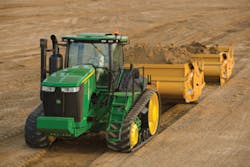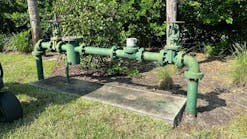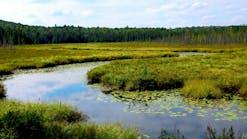Before the dedicated motor scraper, there was a smaller version: the towed scraper, one of the first bulk earthmoving machines invented. Nineteenth-century scrapers were drawn by horses, but were later adapted for use with tractors.
In 1923 Robert LeTourneau designed and built the first modern practical towed scraper. Prior to the development of efficient hydraulic systems after WWII, they were designed to operate behind crawler tractors via a cable control unit.
Before the dedicated motor scraper, there was a smaller version: the towed scraper, one of the first bulk earthmoving machines invented. Nineteenth-century scrapers were drawn by horses, but were later adapted for use with tractors.In 1923 Robert LeTourneau designed and built the first modern practical towed scraper. Prior to the development of efficient hydraulic systems after WWII, they were designed to operate behind crawler tractors via a cable control unit.
[text_ad]
By the mid-1940s, there were roughly 30 US manufacturers offering their own adaptations, including cable- and hydraulically operated styles.
The towed scraper remained popular until the motor scraper appeared in the 1970s. The invention of the articulated dump truck and hydraulic excavators further diminished its prevalence. However, operators continue to find uses for them and consider them valuable elements of their fleets.
Dirt Fun "Motor graders are different," insists Chad Webre, product specialist for scraper systems with John Deere Construction Equipment. "They're highly specialized. We can't do all they can; we can't bank or tilt." However, he adds, compared with motor graders, dump trucks, or conventional scrapers, the pull-type scraper is cheaper to operate.
"Anywhere you can use it, you should," he urges, "even if you're top-loading or pulling two or three in tandem. They go anywhere conventional earth movers can for lower cost and investment." He estimates that they are 30-50 cents cheaper per cubic yard to operate and one-third the cost of initial investment. The main advantage is that you are excavating, carrying, and leveling with one operator and one machine.
John Deere, which Webre says is the market leader in pull-type scrapers, offers nine models of that "one machine" in two styles: the carry-all style and the ejector style. Higher-capacity models like the 1812C, 2112C, 2112E, and 1810E are popular because of escalating fuel prices. Additionally, the 1810E is popular with dealer-owned rental fleets because they can fit two on a trailer for transporting to customer job sites.
The choice of style comes down to job site. "They all load the same," Webre explains, "but the carry-all has a rotating bucket inside the frame that uses gravity to unload. It pivots in the rear and is less aggressive the deeper you go, so it performs well in sandy conditions or topsoil with no rock. The ejector has more force; it's hydraulically driven and pivots in the front, so it works better in heavy clay, gumbo, or wet, dense, compacted soils."
While the pull-type scrapers are versatile in application, use and configuration, there are limitations with any equipment, Webre acknowledges. Capable of single, tandem, and even triple configurations, it isn't suited to smaller or tighter job sites in the long configurations. However, he points out, "You can remove one and still be productive if it's wet, or you can top-load."
It doesn't work well on sites that feature excessive or large aggregates, either, although the John Deere models do have options for moderately rocky conditions.
John Deere's customer base includes contractors involved in highway construction (everything from roads and bridges to all sorts of municipal jobs), oil-and-gas, mining, the stockpiling of coal, the digging of commercial ponds, the construction of sports fields and parks, landfill work, the regrading of cattle feed lots for improved wastewater runoff, and the reclamation of grass waterways to drain corn fields. "It needs to be excavated every five to 10 years to bring the nutrients back up to the field," Webre explains.
JD customers have even used their scrapers in some rather unusual ways. One customer in California used it to load and haul sea salt harvested from evaporation ponds. Another customer drove it into the Gulf of Mexico to load sand underwater that it then spread on the beach.Although Webre doesn't recommend continued use in such corrosive environments, he says, "It's fun to operate and fun to run." Ride comfort is very good, he indicates, with big, soft tires and a fully active seat. "That's an issue with self-propelled scrapers," he points out. "It's a young man's game."
The technology is fun, too, he continues. The auto-load feature "makes a novice operator productive." It allows an operator to move 55 cubic yards per cycle with little training. The push-button load feature measures the parameters in a loading cycle and controls the blade, lifting and lowering it based on rpm and wheel slip, for a consistent cut with no gouging. Fine adjustments enable the steep angle blade to produce a smooth cut profile.
Other technology offered by JD includes iTech, which records functions for repeatability, and iGrade, Deere's own proprietary guidance system. Webre says it's commonly used in agriculture and for levee and ditch work. "If you look at the history of the pull-type scraper, it started in agriculture to level the land; they used laser to precision-level the fields." These days, more scrapers are using integrated GPS systems.
In addition to offering its own GPS system, John Deere's tractor system features open architecture that works with other brands. Webre believes that an advantage of their system is that it's the only one that builds the tractor and scraper and integrated technology-designed with each other in mind-but that it's compatible with other brands as well.
Seeking Guidance "I'd rather have GPS on the scraper than the dozer on some sites," says Zach Pieper, manager of Pieper Inc. Excavating in Wever, IA. Founded in 1966, the company is experienced in earthwork, underground utilities, foundation excavation, drainage tile, dewatering up to 45,000 gpm, sewer, water main, industrial waste removal, soil remediation, trucking and wetlands improvement. They are also accomplished DoT and railroad contractors.
Although they perform wetlands work in an 11-state range, they confine scraper work to a 90-mile radius, focusing on levees, schools, apartment complexes and strip malls. "Commercial site prep is most of our work," Pieper says, "plus DOT."
Grade control technology is an integral part of their process. No fewer than eight machines are equipped with Topcon GPS automated grade control. Their foreman's pickups are equipped with GPS grade monitoring systems, and they use five complete Topcon base and rover GPS systems, four grade lasers, and three pipe lasers. They also use AgTek Earthworks 3-D modeling software for bidding, machine control and progress documentation, using Topcon's mmGPS system to achieve grading tolerances of one half-inch.
"Our scrapers are outfitted with automatic GPS, which enables us to cut the site almost to a perfect grade," Pieper says. "It's almost as good as a motor grader. It's amazing what it can do." As an example, he mentions a school parking lot they graded, describing it as a bowl with drainage. "The dozer hardly had a blade load; the scraper cut it right to grade.
Most of Pieper's competition doesn't use GPS on their scrapers, but he finds it beneficial in many ways. It reduces manpower because there's no need to check the laser or survey pins. "The operator stays in the cab and works," he explains. "He doesn't have to read pins, figure the elevation and slope, be a grade-checker or pull string lines."
A scraper is more cost-effective when working in the right area, Pieper states. For one thing, it uses less fuel. And, because it produces consistent results, there is less rework. "With no rework, you can double productivity. It really speeds up the schedule. The guys don't knock over stakes; they know where they are."
Engineers provide a CAD file and then Pieper's crew puts the contours and point elevations into a 3D configuration, with the help of an engineer from Burlington to build the model. Next, they load it in the machine via USB, set up a GPS base station to send corrections to the machine, and go. "It's repeatable," Pieper adds, which means further time savings on many jobs.
Dubbing it a "jack of all trades," Pieper praises the scraper's versatility. "It depends on the site. It's not the best tool all the time, but it can usually make do." Sometimes it makes do by sitting it out. "With a scraper tractor, we can use just the twin-engine Cat 627 tractors if needed-without the Reynolds scrapers."
The scraper has many additional advantages over other bulk earthmoving machinery, he says. It's economical, with a lower cost to buy. It's lightweight, with lighter, big tires that generate lower ground pressure than other equipment. It's efficient because it loads itself, hauls, dumps, and cuts to grade, all by itself. With an articulated truck, for example, you need an excavator to load and dump, and, as Pieper points out, you're subject to downtime if a hydraulic hose breaks.
Another advantage is the scraper's ability to work in many soil types. "It works in most conditions, although it has limited use in harder clay and it's useless in rock," Pieper says. Nevertheless, it can strip topsoil and work in wet conditions. That's definitely a benefit for Pieper, who often works in wet, muddy conditions when completing wetlands work.
Recently, Pieper did 18 miles of levee work in the Green Bay River Bottom north of Ft. Madison, IA, the same 14,000-acre river bottom where the company's shop is located. The two-part project required Pieper Excavating to modify the levee to meet Corps of Engineers specifications for 100-year flood certification. During the flood of 2008, the levee was changed to hold a "tall" river. Pushed up with dozers, the raised levee held the river back. "It cost several hundred thousand dollars to put up." However, Pieper explains, "FEMA requires the levee to be restored to its previous condition, so we are lowering it."
Luckily, 2012 was a dry year in the Midwest. However, Pieper knows that only the levee surface is dry. "It's pretty wet with heavy equipment, and the scrapers don't load well when it's wet, especially with higher material density [clay]."
In situations like that, Pieper top-loads the scraper with an excavator, but is careful not to load more than 70% full because he says they don't do well if loaded more than that with this type of material.
"Any hauling system is a compromise," he indicates. For example, 40-ton articulated trucks may have more capacity, but they always have to be loaded with an excavator.
The scraper is easy to run, offers the lowest cost per yard and provides more versatility. "We once used it as a rock box," Pieper recalls. "We were burying pipe in the winter and it was too cumbersome to haul the rock, so used an excavator to scoop rock into the scraper instead of wearing out a backhoe."
Dirt Work, Texas Style Wayne Dworaczyk, owner of Dirt Works in Blanco, TX, finds plenty of ways to use the two scrapers he purchased from K-tec Earthmovers Inc. An experienced contractor in all phases of road work, site work, and every type of commercial and residential grading and excavation, he specializes in lakes, water features, and ranch work-specifically, ranch roads. "We move dirt onsite at air strips sometimes," he says. "But mostly we do lakes and ranch roads.
"A lot of people are moving here from California," Dworaczyk continues. The area between San Antonio and Austin has seen increasing sales of ranches to out-of-state buyers attracted by the region. "They buy ranches, clear them, and sell them. We use scrapers to enhance the properties." Because it's a dry area, he explains, lakes add value to a property. Roads, of course, provide beneficial access.
Dirt Works, established 14 years ago, is currently adding eight new lakes and 10 miles of fresh roads at one ranch. "It has wildlife now, but it used to have cattle," Dworaczyk notes, adding that the buyers usually maintain these ranches; development isn't typically performed.
Affiliated with the construction industry since he finished high school in 1979, Dworaczyk has worked in all areas of excavation, from scraper crew to backhoe and dump truck operation. He is familiar with underground piping, utilities and foundations, having laid major water and sewer lines for Garney Companies, one of the country's top utility contractors, located in Kansas City, MO.
In fact, it was there, while in charge of digging and laying pipe and doing backfill and finish work, that he got his nickname, Dirt. The man knows dirt and how to move it. He owns two 36-cubic-yard K-tec 1236 scraper models and has been leasing two of K-tec's most popular 33-cubic-yard 1233 scraper models.
Featuring an extendable rack and sidewalls, the 1236 has the best load-to-scraper weight ratio and the lowest cost per yard of any unit in K-tec's lineup. The 1233, K-tec's most popular model, is a multipurpose machine that works in any soil condition with unmatched fuel efficiency. It can be used in a train for a tandem heaped capacity of 66 yards. Both work well on the clay and caliche soils common in east Texas.
Caliche material is chalky, between clay and rock, of which there is also plenty. "This is hill country," Dworaczyk says. "There is a lot of rock. We're often building on hillsides, moving materials. Nothing is flat here." Thinner rock from ledges is hauled with his scrapers, but he mills thicker rock 8 inches deep with a 10-foot-wide Iron Wolf milling machine before picking it up with the scrapers or top-loading the small rock.
The scrapers can even work in certain wet soils. "There's a lot of underground water around here, but we can still work with wet clay," says Dworaczyk, although if he's working in "sloppy mud," he uses an excavator to top-load the scraper. It's still the most efficient piece of machinery for this kind of work, he says, because "with trucks, you need extra equipment to knock down a job."
In addition to moving dirt with the scrapers to build roads, Dworaczyk uses them to build dams. After separating the topsoil, the clay and the rest of the dirt is used as the core of the dam to stop water migration.
No matter what project he's working on, productivity is one of the reasons he uses the K-tec scrapers. "There's lots of dirt to move in the bottom of a lake. The K-tec scrapers can move 30 yards at a whack. We moved 126,000 yards of dirt on one dam," he recalls, explaining that they work off grade stakes and push the dirt with a D6 dozer.
"Cost is a big thing," too, Dworaczyk says. Pointing out that he gets better fuel economy with the tractor pulling a scraper, as opposed to using an articulated dump, he adds that because there has been so little maintenance required, the cost of the machines is less than renting. The scrapers are backed by a three-year structural warranty. "I hope business keeps up this year so we can purchase a couple more scrapers."By the mid-1940s, there were roughly 30 US manufacturers offering their own adaptations, including cable- and hydraulically operated styles.
The towed scraper remained popular until the motor scraper appeared in the 1970s. The invention of the articulated dump truck and hydraulic excavators further diminished its prevalence. However, operators continue to find uses for them and consider them valuable elements of their fleets.
Dirt Fun
“Motor graders are different,” insists Chad Webre, product specialist for scraper systems with John Deere Construction Equipment. “They’re highly specialized. We can’t do all they can; we can’t bank or tilt.” However, he adds, compared with motor graders, dump trucks, or conventional scrapers, the pull-type scraper is cheaper to operate.
“Anywhere you can use it, you should,” he urges, “even if you’re top-loading or pulling two or three in tandem. They go anywhere conventional earth movers can for lower cost and investment.” He estimates that they are 30-50 cents cheaper per cubic yard to operate and one-third the cost of initial investment. The main advantage is that you are excavating, carrying, and leveling with one operator and one machine.
John Deere, which Webre says is the market leader in pull-type scrapers, offers nine models of that “one machine” in two styles: the carry-all style and the ejector style. Higher-capacity models like the 1812C, 2112C, 2112E, and 1810E are popular because of escalating fuel prices. Additionally, the 1810E is popular with dealer-owned rental fleets because they can fit two on a trailer for transporting to customer job sites.
The choice of style comes down to job site. “They all load the same,” Webre explains, “but the carry-all has a rotating bucket inside the frame that uses gravity to unload. It pivots in the rear and is less aggressive the deeper you go, so it performs well in sandy conditions or topsoil with no rock. The ejector has more force; it’s hydraulically driven and pivots in the front, so it works better in heavy clay, gumbo, or wet, dense, compacted soils.”
While the pull-type scrapers are versatile in application, use and configuration, there are limitations with any equipment, Webre acknowledges. Capable of single, tandem, and even triple configurations, it isn’t suited to smaller or tighter job sites in the long configurations. However, he points out, “You can remove one and still be productive if it’s wet, or you can top-load.”
It doesn’t work well on sites that feature excessive or large aggregates, either, although the John Deere models do have options for moderately rocky conditions.
John Deere’s customer base includes contractors involved in highway construction (everything from roads and bridges to all sorts of municipal jobs), oil-and-gas, mining, the stockpiling of coal, the digging of commercial ponds, the construction of sports fields and parks, landfill work, the regrading of cattle feed lots for improved wastewater runoff, and the reclamation of grass waterways to drain corn fields. “It needs to be excavated every five to 10 years to bring the nutrients back up to the field,” Webre explains.
JD customers have even used their scrapers in some rather unusual ways. One customer in California used it to load and haul sea salt harvested from evaporation ponds. Another customer drove it into the Gulf of Mexico to load sand underwater that it then spread on the beach.
Although Webre doesn’t recommend continued use in such corrosive environments, he says, “It’s fun to operate and fun to run.” Ride comfort is very good, he indicates, with big, soft tires and a fully active seat. “That’s an issue with self-propelled scrapers,” he points out. “It’s a young man’s game.”
The technology is fun, too, he continues. The auto-load feature “makes a novice operator productive.” It allows an operator to move 55 cubic yards per cycle with little training. The push-button load feature measures the parameters in a loading cycle and controls the blade, lifting and lowering it based on rpm and wheel slip, for a consistent cut with no gouging. Fine adjustments enable the steep angle blade to produce a smooth cut profile.
Other technology offered by JD includes iTech, which records functions for repeatability, and iGrade, Deere’s own proprietary guidance system. Webre says it’s commonly used in agriculture and for levee and ditch work. “If you look at the history of the pull-type scraper, it started in agriculture to level the land; they used laser to precision-level the fields.” These days, more scrapers are using integrated GPS systems.
In addition to offering its own GPS system, John Deere’s tractor system features open architecture that works with other brands. Webre believes that an advantage of their system is that it’s the only one that builds the tractor and scraper and integrated technology-designed with each other in mind-but that it’s compatible with other brands as well.
Seeking Guidance
“I’d rather have GPS on the scraper than the dozer on some sites,” says Zach Pieper, manager of Pieper Inc. Excavating in Wever, IA. Founded in 1966, the company is experienced in earthwork, underground utilities, foundation excavation, drainage tile, dewatering up to 45,000 gpm, sewer, water main, industrial waste removal, soil remediation, trucking and wetlands improvement. They are also accomplished DoT and railroad contractors.
Although they perform wetlands work in an 11-state range, they confine scraper work to a 90-mile radius, focusing on levees, schools, apartment complexes and strip malls. “Commercial site prep is most of our work,” Pieper says, “plus DOT.”
Grade control technology is an integral part of their process. No fewer than eight machines are equipped with Topcon GPS automated grade control. Their foreman’s pickups are equipped with GPS grade monitoring systems, and they use five complete Topcon base and rover GPS systems, four grade lasers, and three pipe lasers. They also use AgTek Earthworks 3-D modeling software for bidding, machine control and progress documentation, using Topcon’s mmGPS system to achieve grading tolerances of one half-inch.
“Our scrapers are outfitted with automatic GPS, which enables us to cut the site almost to a perfect grade,” Pieper says. “It’s almost as good as a motor grader. It’s amazing what it can do.” As an example, he mentions a school parking lot they graded, describing it as a bowl with drainage. “The dozer hardly had a blade load; the scraper cut it right to grade.
Most of Pieper’s competition doesn’t use GPS on their scrapers, but he finds it beneficial in many ways. It reduces manpower because there’s no need to check the laser or survey pins. “The operator stays in the cab and works,” he explains. “He doesn’t have to read pins, figure the elevation and slope, be a grade-checker or pull string lines.”
A scraper is more cost-effective when working in the right area, Pieper states. For one thing, it uses less fuel. And, because it produces consistent results, there is less rework. “With no rework, you can double productivity. It really speeds up the schedule. The guys don’t knock over stakes; they know where they are.”
Engineers provide a CAD file and then Pieper’s crew puts the contours and point elevations into a 3D configuration, with the help of an engineer from Burlington to build the model. Next, they load it in the machine via USB, set up a GPS base station to send corrections to the machine, and go. “It’s repeatable,” Pieper adds, which means further time savings on many jobs.
Dubbing it a “jack of all trades,” Pieper praises the scraper’s versatility. “It depends on the site. It’s not the best tool all the time, but it can usually make do.” Sometimes it makes do by sitting it out. “With a scraper tractor, we can use just the twin-engine Cat 627 tractors if needed-without the Reynolds scrapers.”
The scraper has many additional advantages over other bulk earthmoving machinery, he says. It’s economical, with a lower cost to buy. It’s lightweight, with lighter, big tires that generate lower ground pressure than other equipment. It’s efficient because it loads itself, hauls, dumps, and cuts to grade, all by itself. With an articulated truck, for example, you need an excavator to load and dump, and, as Pieper points out, you’re subject to downtime if a hydraulic hose breaks.
Another advantage is the scraper’s ability to work in many soil types. “It works in most conditions, although it has limited use in harder clay and it’s useless in rock,” Pieper says. Nevertheless, it can strip topsoil and work in wet conditions. That’s definitely a benefit for Pieper, who often works in wet, muddy conditions when completing wetlands work.
Recently, Pieper did 18 miles of levee work in the Green Bay River Bottom north of Ft. Madison, IA, the same 14,000-acre river bottom where the company’s shop is located. The two-part project required Pieper Excavating to modify the levee to meet Corps of Engineers specifications for 100-year flood certification. During the flood of 2008, the levee was changed to hold a “tall” river. Pushed up with dozers, the raised levee held the river back. “It cost several hundred thousand dollars to put up.” However, Pieper explains, “FEMA requires the levee to be restored to its previous condition, so we are lowering it.”
Luckily, 2012 was a dry year in the Midwest. However, Pieper knows that only the levee surface is dry. “It’s pretty wet with heavy equipment, and the scrapers don’t load well when it’s wet, especially with higher material density [clay].”
In situations like that, Pieper top-loads the scraper with an excavator, but is careful not to load more than 70% full because he says they don’t do well if loaded more than that with this type of material.
“Any hauling system is a compromise,” he indicates. For example, 40-ton articulated trucks may have more capacity, but they always have to be loaded with an excavator.
The scraper is easy to run, offers the lowest cost per yard and provides more versatility. “We once used it as a rock box,” Pieper recalls. “We were burying pipe in the winter and it was too cumbersome to haul the rock, so used an excavator to scoop rock into the scraper instead of wearing out a backhoe.”
Dirt Work, Texas Style
Wayne Dworaczyk, owner of Dirt Works in Blanco, TX, finds plenty of ways to use the two scrapers he purchased from K-tec Earthmovers Inc. An experienced contractor in all phases of road work, site work, and every type of commercial and residential grading and excavation, he specializes in lakes, water features, and ranch work-specifically, ranch roads. “We move dirt onsite at air strips sometimes,” he says. “But mostly we do lakes and ranch roads.
“A lot of people are moving here from California,” Dworaczyk continues. The area between San Antonio and Austin has seen increasing sales of ranches to out-of-state buyers attracted by the region. “They buy ranches, clear them, and sell them. We use scrapers to enhance the properties.” Because it’s a dry area, he explains, lakes add value to a property. Roads, of course, provide beneficial access.
Dirt Works, established 14 years ago, is currently adding eight new lakes and 10 miles of fresh roads at one ranch. “It has wildlife now, but it used to have cattle,” Dworaczyk notes, adding that the buyers usually maintain these ranches; development isn’t typically performed.
Affiliated with the construction industry since he finished high school in 1979, Dworaczyk has worked in all areas of excavation, from scraper crew to backhoe and dump truck operation. He is familiar with underground piping, utilities and foundations, having laid major water and sewer lines for Garney Companies, one of the country’s top utility contractors, located in Kansas City, MO.
In fact, it was there, while in charge of digging and laying pipe and doing backfill and finish work, that he got his nickname, Dirt. The man knows dirt and how to move it. He owns two 36-cubic-yard K-tec 1236 scraper models and has been leasing two of K-tec’s most popular 33-cubic-yard 1233 scraper models.
Featuring an extendable rack and sidewalls, the 1236 has the best load-to-scraper weight ratio and the lowest cost per yard of any unit in K-tec’s lineup. The 1233, K-tec’s most popular model, is a multipurpose machine that works in any soil condition with unmatched fuel efficiency. It can be used in a train for a tandem heaped capacity of 66 yards. Both work well on the clay and caliche soils common in east Texas.
Caliche material is chalky, between clay and rock, of which there is also plenty. “This is hill country,” Dworaczyk says. “There is a lot of rock. We’re often building on hillsides, moving materials. Nothing is flat here.” Thinner rock from ledges is hauled with his scrapers, but he mills thicker rock 8 inches deep with a 10-foot-wide Iron Wolf milling machine before picking it up with the scrapers or top-loading the small rock.
The scrapers can even work in certain wet soils. “There’s a lot of underground water around here, but we can still work with wet clay,” says Dworaczyk, although if he’s working in “sloppy mud,” he uses an excavator to top-load the scraper. It’s still the most efficient piece of machinery for this kind of work, he says, because “with trucks, you need extra equipment to knock down a job.”
In addition to moving dirt with the scrapers to build roads, Dworaczyk uses them to build dams. After separating the topsoil, the clay and the rest of the dirt is used as the core of the dam to stop water migration.
No matter what project he’s working on, productivity is one of the reasons he uses the K-tec scrapers. “There’s lots of dirt to move in the bottom of a lake. The K-tec scrapers can move 30 yards at a whack. We moved 126,000 yards of dirt on one dam,” he recalls, explaining that they work off grade stakes and push the dirt with a D6 dozer.
“Cost is a big thing,” too, Dworaczyk says. Pointing out that he gets better fuel economy with the tractor pulling a scraper, as opposed to using an articulated dump, he adds that because there has been so little maintenance required, the cost of the machines is less than renting. The scrapers are backed by a three-year structural warranty. “I hope business keeps up this year so we can purchase a couple more scrapers.”






